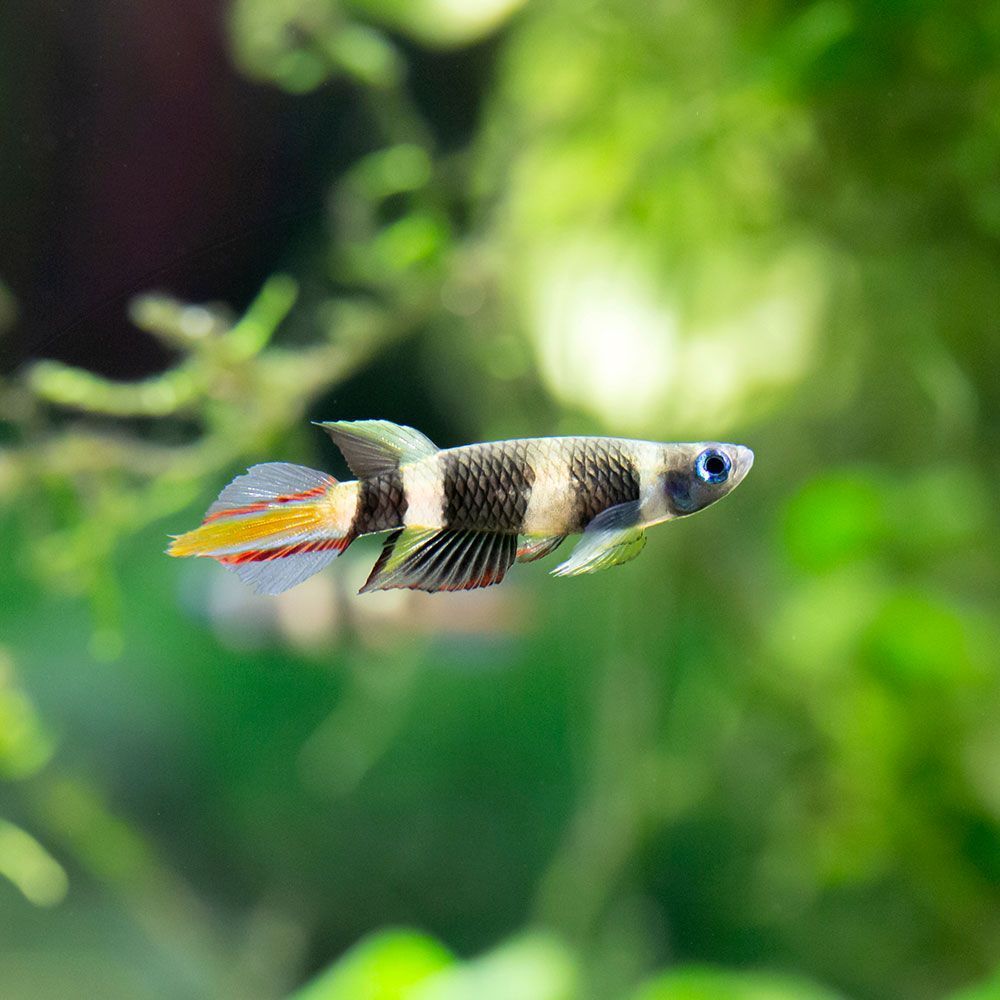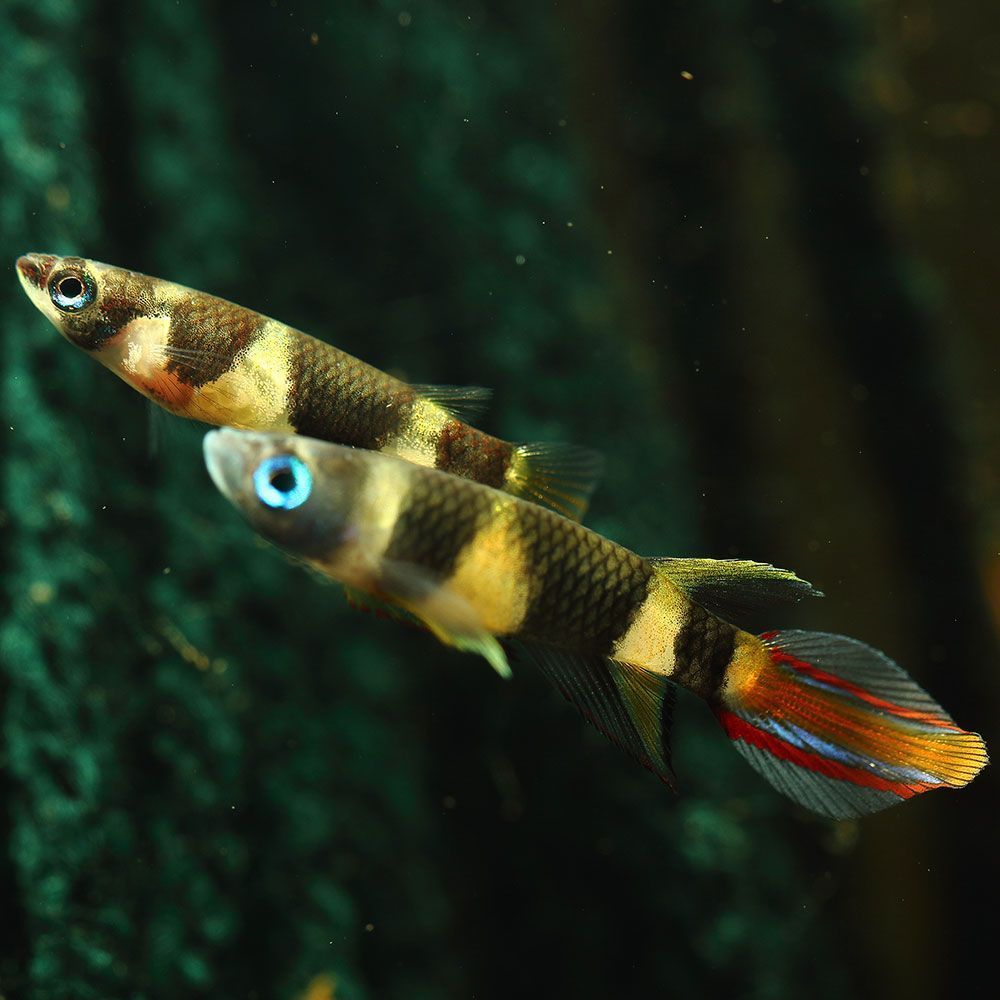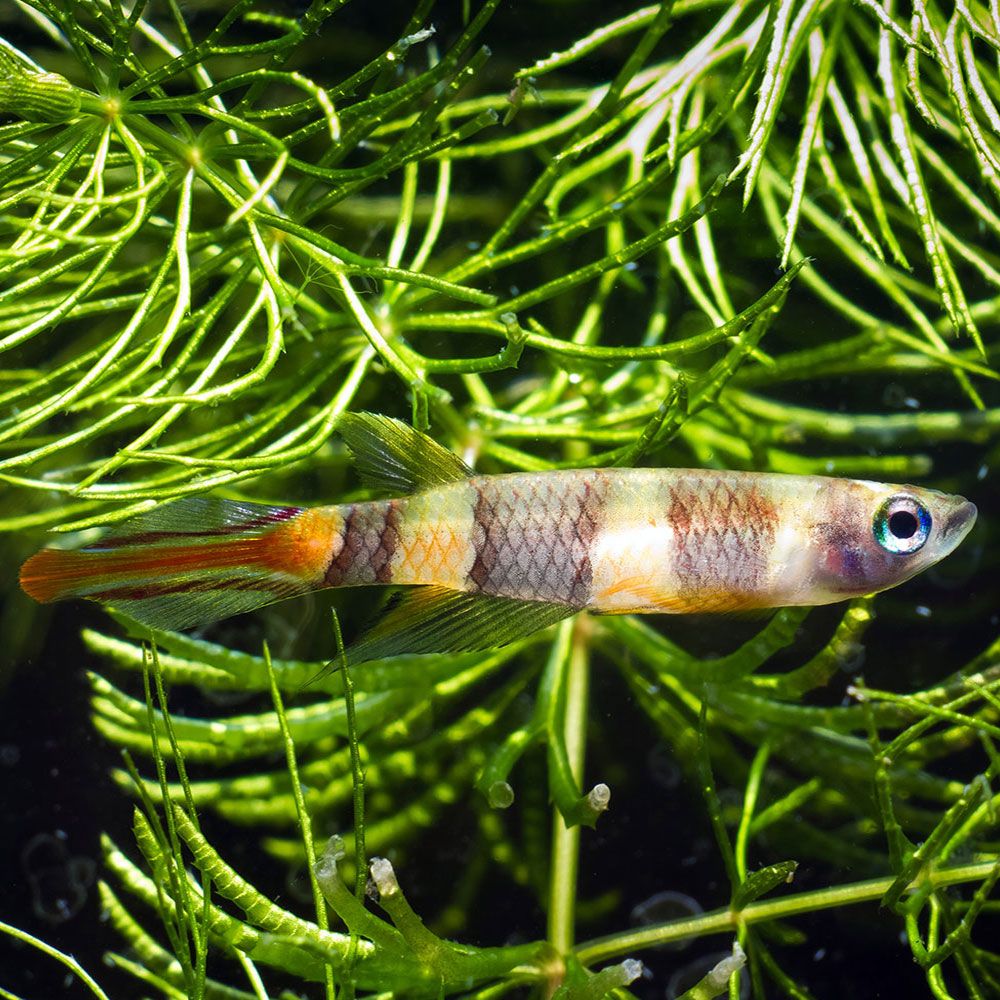The clown killifish is a sight to look at with its beautiful color combinations. The stripes on its body give it a majestic appearance. The little freshwater fish is a great choice for peaceful community tanks for dwarf species.
It is pretty easy to care for, so even beginner aquarists can bring this fish home. The species is a voracious carnivore and makes no fuss while eating.
So, if you are ready to add it to your home aquarium, keep reading!
What is a Clown Killifish?
A clown killifish is a freshwater fish particularly known for its two color combination and is famous among the home aquarium keepers.
Here are a few more facts about the clown killifish:
| Origin | Coastal lowlands of southern Guinea and Sierra Leone to the northwest areas of Liberia, West Africa |
| Order | Cyprinodontiformes |
| Family | Nothobranchiidae |
| Scientific Name | Epiplatys annulatus |
| Common Names | Clown killie, clown killifish, rocket killie, rocket killifish, rocket panchax, banded panchax |
| IUCN Red List Status | Least Concern |
| Appearance | Torpedo shaped body, forked tail, big eyes, blue fins, alternating blue-black and white stripes on the body, red rays in the tail fin |
| Size | Female: up to 3 cm (1.2 in); Male: Up to 3.5-4 cm (1.4-1.6 in) |
| Lifespan | Up to 3-5 years |
| Temperament | Peaceful, friendly, predatory |
| Tank Level | Middle to top dweller |
| Water Temperature | 72-78 °F (22-26 °C) |
| pH Level | 5.5-7 |
| Water Hardness | Up to 8 dGH |
| Care Level | Easy to Intermediate |
| Minimum Tank Size | 10 gallons for 2-3 pairs |
| Tank Environment | Heavily vegetated, multiple hiding spots, enough free space to swim |
| Diet | Carnivorous |
| Tank Mates | Own group, other similar-sized, similar-tempered species |
Where is Clown Killifish Naturally found?
The clown killifish is naturally found in the coastal lowlands of southern Guinea and Sierra Leone to the northwest areas of Liberia in West Africa.
This species likes swamps and slow-flowing waters of streams and small rivers flowing through open grasslands and tropical rainforests.
The fish is mostly spotted in soft acidic warm freshwater among aquatic plants. But sometimes, you may also see it in brackish waters.
According to The IUCN Red List of Threatened Species assessment 2020, this species is labeled Least Concern.
Which family does the Clown Killifish belong?
This fish is part of the Nothobranchiidae family under the Cyprinodontiformes order and is scientifically known as Epiplatys annulatus.
However, a few common names for this fish are also popular worldwide, like clown killifish, clown killie, rocket killie, rocket killifish, rocket panchax, and banded panchax.
Within its locality, the same fish from different regions are given different names. This is done to avoid hybridization of the fish and maintain a pure bloodline.
Fun Fact: The word ‘Killifish’ comes from the Dutch word for ‘a channel.’ This is related to the fish’s affinity for slow-moving streams and swamps.
How does a Clown Killifish look?

A clown color fish has two main color combinations with a couple of different colors for its tail.
What is the Size of Clown Killifish?
This is a tiny species where the adult female grows up to only 3cm (1.2 in) while the mature male is as large as 3.5-4 cm (1.4-1.6 in). People refer to it as a “dwarf” animal because of its small stature.
What is the Color of Clown Killifish?
The color of the clown killifish resembles the clown makeup in the circus. It has shades of white, blue, red, and black all present on its body.
But this amalgamation of colors is not an abstract mixture. It has a striped pattern that is repeated asymmetrically on its body.
The body of this fish has blue-black stripes, which are alternated with white stripes.
The caudal and dorsal fins often have varied colors like red flecked blue, or light blue. The caudal fin has shooting ray-like splashes of colors, which vary from shades of red to orange.
There might be color variations within the same brood. In different variants, you may notice differences in color intensity, stripe width, and band positioning.
The most notable variants are Conakry (from Guinea), Kasewe Forest (from Sierra Leone), and Monrovia (from Liberia).
What are the Features of Clown Killifish?
The body of the clown killifish is shaped like a rocket or torpedoes. It also flaunts an upturned mouth and large eyes. The tail fin is forked, and dorsal fins are set quite far back toward the tail.
It has a reflective bottom belly for protection from predators waiting below.
What is the difference between male and female Clown Killifish species?
There are distinct differences between the males and females of this species. So, it is quite easy to tell these apart.
The first difference that can be noticed is in the color and the structure of the anal fins.
The male clown killifish has red or blue anal fins and long rays under the caudal fins. The long rays can be as long as the caudal itself.
While the female fish has shorter anal fins, these are usually transparent. Dorsal and caudal fins might have some red or yellow rays.
The female fish is less vibrant and shorter in size and also lacks fin extensions like thatof the male.
How do Clown Killifish behave in a fish tank?
The clown killifish is a peaceful species and friendly toward most other fish. This is a schooling fish, but it can show tendencies to separate into pairs and wander off apart from the bigger group.
The clown is also a popular predator species. It waits for its prey silently instead of actively chasing them. It is also a good jumper, so keep it in a tank with tightly-fitted lids.
How Long does a Clown Killifish Live?
The clown killifish will live around 3 to 5 years in an aquarium. However, some aquarium owners even lose their fish within 2 years due to poor care.
Author’s Note: Whenever you walk past its aquarium, the curious fish will come near the aquarium glass to check on the surroundings.
How to Take Care of Clown Killifish in an Aquarium?

If you want to keep Clown Killifish in your aquarium, they require specific care otherwise they will not live longer.
What should be the Tank Size for Clown Killifish?
It is recommended to keep 4 pairs in a 15-gallon tank. 2-3 pairs can be kept in a tank as small as 10 gallons.
This fish needs to be housed in pairs as the smallest unit. But a bigger group will help the fish feel less shy and show interesting activities.
Some recommend keeping them in 5-gallon nano tanks, but it may not be enough as these need strong water flow to keep them clean. This fish does not like strong currents, so in my experience, it’s better to use a larger tank.
If there are other tank mates, always go for a bigger tank size to provide enough room to swim and explore.
What is the Water Chemistry of the Aquarium for Clown Killifish?
The clown killifish does not have a long lifespan. But the best care can help your fish live a longer life. So follow these parameters with close attention!
- pH Levels: 5.5-7
- Water Temperature: 72-79 °F (22-26 °C)
- Water Hardness: Up to 8 dGH
- Carbonate Hardness: Up to 6 dKH
- Ammonia: 0 ppm
- Nitrite: 0 ppm
- Nitrate: Below 20-30 ppm
What should be the Tank Environment for Clown Killifish?
To make your clown killifish feel at home, you must make it a lovely tank. Let us tell you how to make that happen.
Is Substrate needed for Clown Killifish?
This fish is not choosy about substrate as it usually swims in the top and middle water columns. So you can pick whatever suits you here.
It does not dig around much, so you can use gravel, sand, or even keep it bare. If you want to make the colors on this fish pop, then use a dark substrate.
Are Plants needed for Clown Killifish?
The natural environment of clowns is heavily planted. So your fish will like a good amount of vegetation in its tank. Floating plants are also a great option.
You can use guppy grass, water lettuce, red-root floater, frogbit, java ferns, and water sprites as a few choices for this tank.
Which type of Lighting is required for Clown Killifish?
The clown killifish prefers dim lighting, which can be established with floating plants. Choose extremely subdued light settings for your tank.
What Décor is needed for Clown Killifish?
You can use decorations like driftwood, rocks, caves, and such things, which provide hiding spots for this fish.
Sometimes, the clown killie becomes a little shy and likes to hide and rest. But they also go out exploring as a pair, so keep enough free space for swimming.
What type of Filtration is needed for Clown Killifish?
Filtration is a little tricky for clown killies, as it does not enjoy strong currents. But you must have a filter to keep the tank free of waste and clean the water.
You can take care of this dilemma in the following two ways:
1. Install a low-flow filter and put plants and decor in front of it. This will help the currents die away
OR
2. You can forgo the filter and use sufficient plants to absorb all the ammonia, nitrites, and nitrates from the fish waste. In addition, perform 50% water change every few days.
What should be the Water Flow Rate for Clown Killifish?
The fish likes a slow water flow rate that replicates that of the stand-still swamps of its natural habitat.
Fish Care Tip: Keep the water temperature on the lower side of the range. This will slow down their metabolism and expand their lifespan.
What does Clown Killifish eat?
This fish needs a carnivorous diet. It accepts all types of food – live, frozen, and dried but likes live food the most. So, you must include the following in its diet.
- Confused flour beetles
- Confused flour beetle larvae
- Microworms
- Moina
- Mosquito larvae
- Small daphnia
- Small grindal worms
- Vinegar eels
- Bloodworms
- Walter worms
- Copepods
- Fruit flies
- Baby brine shrimp
- Mysis shrimp
- Grindal worms
- High-quality flake food
The small mouths make it difficult to feed them. So, crush its food into small pieces and feed them once or twice a day.
What Tank Mates can Clown Killifish live with?
Before adding any other tank mates, make sure you keep them in groups. A school of 10 is the best to keep this species happy!
This peaceful species makes great tank mates for any other similar-sized fish of the same temperament. Some of the tank mates that you can keep with a clown killifish are:
- Sparkling gouramis
- Minnows
- Endler’s livebearers
- Small barbs
- Guppy fish
- Small plecos
- Honey gouramis
- Corydoras catfish
- Celestial pearl danios
- Neon tetras
- Pea puffers
- Chili rasboras
- Bettas
- Molly fish
Which Tank Mates Should you Avoid with Clown Killifish?
To make your clown killifish feel safe, avoid some of these kinds of species:
- Larger aggressive species: They might eat the clown killifish.
- Species with different temperature needs: These would not be compatible.
- Species with strong water flow preference: This fish likes softly flowing, stagnant water.
- Species with different pH needs: Fishes that like a different range of pH will not be suitable for a tank housing this species.
Here’s a quick list of fish that belong in the above categories:
- Crayfish
- African dwarf frog
- Freshwater crabs
- Cichlids
- Arowanas
- Tiger fish
What are the Common Diseases that Clown Killifish can Acquire?
This species is susceptible to the common freshwater fish diseases that afflict most species. Read on to know the symptoms of the diseases to provide your fish with the best treatment in time.
| Disease Name | Causes | Symptoms | Treatment |
|---|---|---|---|
| Fish lice | Parasitic Infection | Small spots on the skin | Use tweezers to pull off individual lice, treat the tank with Dimlin |
| Flukes | Parasitic Infection | Swims too close to the surface, clamped fin, excess mucus | Keep water clean, lower the water temperature |
| Ich | Protozoan Parasitic Infection | Flashing, white spots, inactivity, appetite loss | Raise water temperature, add aquarium salts or ich medication |
| Fin rot | Bacterial Infection | Fin discoloration or redness, inactivity, appetite loss, fin disintegration, fin fraying | Improve water quality, remove any object that may hurt the fish, and add antibiotics |
| Columnaris | Bacterial Infection | Inactivity, appetite loss, fin fraying, white patches | Reduce stress, add antibiotics, enhance water quality |
| Hole in the head disease | No singular cause | One or two pits/holes in the skin of the head | Fix water quality, Remove activated carbon |
Quick Tip: If there are invertebrates in your tank, separate these from your clown killifish before treatment. Copper-containing fish medication is toxic to them.
How to Breed Clown Killifish?
Clown killies are pretty easy to breed in the right setup. But to get the best quality brood in a home tank, let us walk you through the steps!
How to Condition & Optain the Specimen for Clown Killifish Breeding?
Choose a male-female pair or one male and 2-3 females for breeding. Multiple females per male helps avoid stressing the female. Make sure all specimens are at least 6 months old – the age of sexual maturity.
Feed them all a high-quality, protein-rich diet of daphnia, brine shrimp, and bloodworms up to three times a day for 1-2 weeks. This will improve the pair’s overall health and condition them to breed.
Introduce the female(s) into the breeding tank a few hours before the male, after conditioning is complete, to let it acclimatize.
What should be the Tank Preparation for Clown Killifish?
Use a 15-gallon tank with the following water parameters:
- Water Temperature: 77-79 °F (25-26 °C)
- pH Levels: 5.5
- Water Hardness: Up to 3 dGH
A bare bottom tank will help you spot the eggs much better. However, studies show that smectite clay substrate can help in the successful breeding of this fish.
Use a heavily vegetated tank with floating plants and mosses to collect the eggs and give the fry suitable hiding spots. You can also use spawning mops to catch the eggs.
Further, you can use rocks and driftwood to make the fish feel secure and encourage breeding.
What is the Mating Process of Clown Killifish?
The male tries to impress the female with an elaborate courtship dance. Once she is ready, the female lays adhesive eggs on the bottom of the floating plants or leaves.
The pair will spawn multiple times over several days.
This fish breeds twice a month, producing up to 1-2 eggs every day and 25 fry per cycle.
What is the Incubation & Fry Development Period for Clown Killifish?
The eggs undergo an incubation period of about 8-14 days to hatch. Maintain a temperature of 75-77 °F (24-25 °C).
If it’s a mature densely vegetated tank, the fry survives on naturally available microorganisms. You can promote microorganism growth in the tank by adding dried leaves.
If your tank is more of a sterile type, try to feed the fry free-floating algae and infusoria.
Within a few days, the fry will be grown enough to eat young nematodes, rotifers, and vinegar eels. And after a week, you can introduce brine shrimp.
How do you maintain the tank for the Clown Killifish fry?
Provide adequate hiding spots for the fry and maintain appropriate water parameters.
Before introduction into the main tank, acclimatize them by using the drip method. In this, you slowly add the main tank’s water into the tank housing the juveniles.
How to Separate Clown Killifish Fry?
The adult fish doesn’t usually prey on its fry. But the parents may scare them away and stress them. Sometimes, the older fry munches on the younger one and eggs.
So, separate the parents from the eggs. And relocate the older fry to another tank from the younger ones.
Breeding Tip: Change the water of the fry tank to keep it clean and ensure the growth of the juveniles. Avoid putting invertebrates in the breeding or fry tank. Otherwise, they’ll eat the eggs and fry.
What to consider while buying Clown Killifish?
If you are getting this fish shipped, do not worry if a pale fish comes to you because it can lose its color temporarily when under stress.
Young clown killifish are less colorful, so do not judge by color when buying juveniles.
A word from FishInAquarium
The beautiful clown killifish will not only make your tank look prettier but also entertain you with their unique personalities. If you want to start off with a small tank or have space issues, this schooling fish is the best choice!
So, if you’re convinced to give this species a chance, share this with other fish lovers and your friends. Or if you have any further queries about this fish, feel free to drop us an email, and we will get things sorted!


